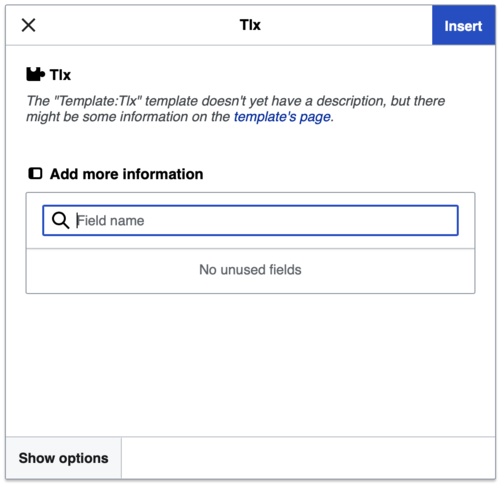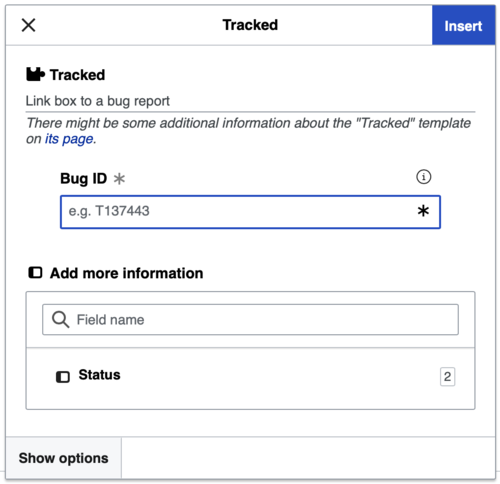Tɛmplet:Unreliable source?
Usage[mali mi di yibu sheena n-niŋ]
This template is intended to be used when a statement is sourced but it is questionable whether the source used is reliable for supporting the statement. It produces a superscripted notation like the following:
- It was actually written by Francis Bacon.[unreliable source?]
Articles tagged with this template will be categorized into Category:All articles lacking reliable references.
Place this template inline, {{Unreliable source?|date=Silimin gɔli May 2024}} following the questionable claim (and any punctuation attached to it). The template should be placed outside the reference (<ref> ... </ref>), within the article's text:
- Potentially controversial statement.
<ref>some alleged source for this</ref>{{Unreliable source?|date=Silimin gɔli May 2024}}Next sentence.
Parameters[mali mi di yibu sheena n-niŋ]
The template has the following optional parameters:
- date: should be set to the month and year when the article was tagged. Example:
{{Unreliable source?|date=Silimin gɔli May 2024}} - reason: a note explaining why you think the source is unreliable as per WP:RS. Displays as a tool tip. Keep it short (one sentence) as longer material belongs on the talk page. It is good to reiterate the reason in your edit summary. Example:
{{Unreliable source?|reason=Your WP:RS-based reason here.|date=Silimin gɔli May 2024}} - sure or certain: if set to "y" or "yes" will remove the question mark from the template's output to denote a degree of certainty that the source is unreliable. Please use this with a
|reason=parameter, and only after a good faith attempt to verify the reliability of the source in question. Example:{{Unreliable source?|sure=y|reason=Your WP:RS-based reason here.|date=Silimin gɔli May 2024}}NOTE: This parameter has an alias,|failed=, which may make more grammatical sense when used with certain redirects like{{verify credibility}}.
When to use and not use this template[mali mi di yibu sheena n-niŋ]
This template should be used to express your doubt about the credibility of a source.
This tag should not be used on unreliably sourced contentious statements about living persons; if a source for such a statement is not reliable, the statement and the source should be removed immediately.
For whole articles or article sections that rely on suspect sources, considering using the banner template {{More citations needed}} or {{More citations needed section}}, respectively, rather than individually tagging a large number of statements.
For sources promoting fringe theories and pseudo-science, the more specific template {{Unreliable fringe source}} can be used. Even more specifically, flag improperly sourced medical claims with {{Unreliable medical source}}.
This tag should not be used to indicate that the sourced material could not be found within a given source. In that case, {{failed verification}} is a better template. For statements that have failed verification and have a questionable would-be source, consider removal of the source (and possibly the statement) over using both tags.
TemplateData[mali mi di yibu sheena n-niŋ]
| This tɛmplet needs to be updated. Please help update this tɛmplet to reflect recent events or newly available information. |

- Main page
- Feedback at MediaWiki or local feedback
- Sandbox (no account required)
- Why are the developers building this?
- Documentation:
- Development:
- Customization
- Known problems
- Requests for Comments (RfCs): Jul 2013 a, Jul 2013 b, Jul 2015, Sep 2015
What is template data?[mali mi di yibu sheena n-niŋ]
Template data is the standardized description of a template, used by the default VisualEditor, the optional 2017 wikitext editor and other tools to improve the template-editing experience for the user. Both VisualEditor and the 2017 wikitext editor include a wizard to edit templates, but for the wizard to be most useful, it needs to present specific information to the user about each template, such as a short description of the template's purpose and its parameters. This information is codified formally (by any wiki editor) using template data.
Editing without template data[mali mi di yibu sheena n-niŋ]
Without template data, each parameter needs to be added manually when inserting a new template.
No information is provided about what the value of the parameter should be.
Editing with template data[mali mi di yibu sheena n-niŋ]
With template data, a list of supported parameters (and their description) is provided for the template.
Template data provides context for each parameter, and makes it much easier for users to modify templates.
Adding template data[mali mi di yibu sheena n-niŋ]
Anyone can help by adding template data to templates (particularly high-profile ones, such as infoboxes) so that they are easier to edit in VisualEditor. The following is a minimal example, placed on a template's documentation page:
<templatedata>{
"description": "insert description here",
"params": {
"first parameter": {
"label": "x",
"description": "x",
"type": "string",
"suggested": true,
"autovalue": "derived automatic value",
"default": "default value",
"required": false
}
}
}</templatedata>
You can also add or edit template data using a GUI, by pressing the following button which appears at the top of the edit page:
The template data tutorial explains in detail how to add template data information to a template.
Adding suggested values for parameters[mali mi di yibu sheena n-niŋ]
The parameter property suggestedvalues lets you define a list of parameter values to be shown to VisualEditor users in a dropdown for easy selection. This can be done either directly in JSON or using the TemplateData editor with no coding required. Both methods are explained in detail below.
Once the values have been added to template data, the VisualEditor will display them in a combo box (a dropdown into which users can also enter a custom value). The user selects the desired value by clicking on it. If the list of values is long - for example, a list of a country’s states - the user can begin typing in the field, whereupon the list will be filtered to show only values containing the typed text. To change an entered value, the user must simply clear the field, and the full dropdown list will appear again. If the user needs a value not included in the list (for example, "message in a bottle") they can type it in manually.
For suggested values to be displayed in the VisualEditor, the parameter’s type must be set to one of the following options:
- content
- line
- string
- number
- unknown
- unbalanced wikitext.
Other types (file, page, template, user, date, boolean, URL) are not currently supported because they have special functionalities in the VisualEditor already (such as autocomplete) which would interfere with the dropdown menu for suggested values in the VisualEditor.
Adding suggested values for parameters in wikitext[mali mi di yibu sheena n-niŋ]
To add suggested values to any parameter type, add the new property “suggestedvalues” to the parameter in JSON. The “suggestedvalues” attribute must be a list of strings.
An example might look like this:
"media_type": {
"label": "Type of media",
"example": "Newspaper",
"type": "string",
"description": "In what medium was the article published?",
"suggestedvalues": [
"Journal",
"Book",
"Newspaper",
"Magazine"
]
}
Adding suggested values for parameters with the template data editor[mali mi di yibu sheena n-niŋ]
For the parameter types listed above, you can add suggested values using the template data editor.
Step 1. Click on "Manage TemplateData".
Step 2. Click on the name of the parameter you want to add suggested values to.
Step 3. If it’s not already, set the type of the parameter to one of the following: content, line, string, number, unknown or unbalanced wikitext. A new input field "Suggested values" will appear. If the parameter is already set to one of these types, the input field should already be visible.
Step 4. Type in the suggested value(s), including any spaces and special characters, and press enter to add it to the list.
Here you can see an example of how to add suggested values in the TemplateData editor.
Used templates[mali mi di yibu sheena n-niŋ]
See also[mali mi di yibu sheena n-niŋ]
- Wikipedia:VisualEditor/TemplateData/List A list of all pages with template data
Used when a statement is sourced but it is questionable whether the source used is reliable for supporting the statement.
| Parameter | Description | Type | Status | |
|---|---|---|---|---|
| Reason | reason | Note explaining why you think the source is unreliable as per WP:RS. Displays as a tool tip | String | optional |
| Certain? | certain sure failed | If set to "y" or "yes" will remove the question mark from the template's output to denote a degree of certainty that the source is unreliable
| Boolean | optional |
| Month and year | date | Month and year of tagging; e.g., 'January 2013', but not 'jan13'
| String | suggested |
| name | name | no description | String | optional |
See also[mali mi di yibu sheena n-niŋ]
Inline templates[mali mi di yibu sheena n-niŋ]
{{Better source needed}}, an alternative to{{Unreliable source?|certain=y}}; especially useful for tagging sources that are low-quality but not necessarily wrong{{Dubious}}, for questionable claims that seem unlikely to be properly sourceable{{Obsolete source}}, for when a source has been surpassed by more recent works{{Primary source inline}}, for misuse of primary source material{{Unreliable fringe source}}, for fringe sources{{Unreliable medical source}}, for fringe medical sources in particular
Lists of templates[mali mi di yibu sheena n-niŋ]
- Wikipedia:Template index/Cleanup/Verifiability and sources
- Wikipedia:Template index/Sources of articles




